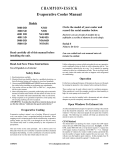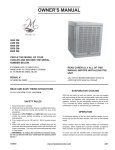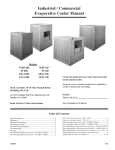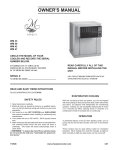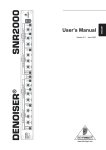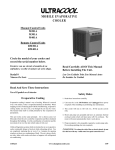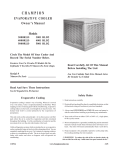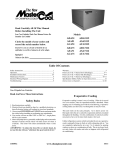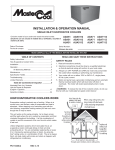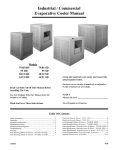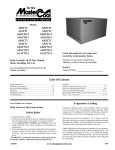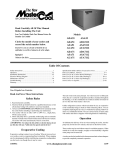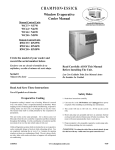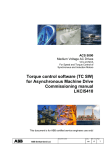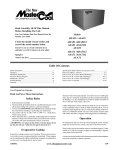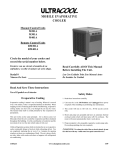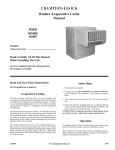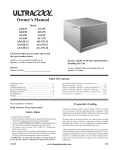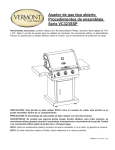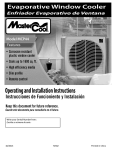Download Champion N40 Specifications
Transcript
CHAMPION•ESSICK Evaporative Cooler Manual Models 3000 DD 3000 SD 4001 DD 4001 SD 5000 DD 5000 SD N31D N30S N43/48D N40/45S N56/66D N55/65S Circle the model of your cooler and record the serial number below. Encierre con un circulo el modelo de su enfriador y escribe el número de serie abajo. Serial # Número De Serie Read carefully all of this manual before installing the unit. Read And Save These Instructions Unlike refrigeration systems which recirculate the air, an evaporative cooler continually brings in fresh air while exhausting old air. You are completely replacing the air every 2 to 4 minutes by opening windows or doors or a combination of both. The air is always fresh, not stale, laden with smoke and odors as happens with refrigerated air conditioning. Vea el Español en el interior Safety Rules 1. Read instructions carefully. 2. Electrical hook up should be done by a qualified electrician, so that all electrical wiring will conform to your local standards. 3. Always turn OFF POWER and UNPLUG motor and pump inside the cooler before installing or performing any maintenance. 4. Your cooler will run on either 120V or 240V A.C., single phase, 60 Hz (cycle) current. 5. Motor and pump have a grounded, molded plug and an automatic thermal overload switch which will shut motor off when it overheats. The motor will restart automatically when it cools down. 6. Pump receptacle is for grounded evaporative cooler pump only. Do not plug anything else into receptacle. WARNING: To reduce the risk of fire or electric shock, do not use this fan with any “solid-state fan speed control device.” Evaporative Cooling Evaporative cooling is nature’s way of cooling. When air is moved over a wet surface, water is evaporated and heat is absorbed. When stepping out of a swimming pool with the wind blowing, evaporative cooling makes you feel cool, even though the air may be warm. The human body itself is cooled primarily by the evaporation of perspiration. This unit works on the same principle. Air is drawn across wet filter pads where the air is cooled by evaporation and then circulated throughout the building. It is this combination of cooled air and the movement of air over the skin which makes it feel cool. 110503-1 Lea con cuidad todo este manual antes de instalar la unidad. Operation For the best cooling performance, if the pads are dry, pre-wet the pads by running the pump for a few minutes before starting the blower. These coolers may be used without water for ventilation purposes. When outside air is cool (for example, at night) or when humidity is high, the water pump can be turned off. A cooler can also be installed with a thermostat and attic exhaust dampers to provide completely automatic operation. Open Windows To Exhaust Air An often misunderstood concept of evaporative cooling is the amount of air that should be exhausted. How much should you open your windows? The fact is that most people do not open their windows enough. The following two methods will help you determine the amount to open your windows. CFM Method You should allow an opening of at least 2 square feet (288 square inches) for each 1000 CFM rating of your unit. Example: At 3654 CFM, model 4001 DD with a 1/2 hp motor requires 7.3 square feet (1052 square inches) of opening (3654/1000 * 2 = 7.3). Multiply the number of windows by window width in inches and divide this into the number of square inches required for your size unit. This will give you the height to open windows. In this example, four 36 inch wide windows should be opened 7.3 inches each. www.championcooler.com 8-08 Champion Air Balancing Method 1. Take a piece of tissue paper and cut it lengthwise into 3 equal strips. 2. Turn your cooler on high cool. 3. Open one window at least six inches wide in each room that you want to cool. 4. Take the piece of tissue paper and put it up against the screen of the open window furthest from the cooler discharge opening. Let go of it. It will do one of three things. IF THEN It falls down. CLOSE all of the windows one inch and try step 4 again. IF THEN It plasters itself to the screen. OPEN all of the windows one inch and try step 4 again. IF THEN It stays on the screen lightly. PERFECT. You are done. Enjoy your cooler. • Remove junction box. The electrical junction box is located in the upper inside corner of the cooler cabinet. Remove the two screws and remove the junction box (Fig. 4). Slide receptacles into slots in junction box. Junction Box Screws Clip Fig. 4 • Hook up electrical. Electrical hook up should be done by a qualified electrician, so that all electrical wiring will conform to your local standards. This unit is suppled with a 120V pump. For 240V pump operation, a 240V pump must be purchased. The fan and pump receptacles will support both 120V and 240V installations. See the wiring diagrams for 120V and 240V installations. Note: Clip pump cord onto cord clip located on the bottom of the junction box to keep cord our of the water. IMPORTANT: When a single speed motor is used, do not use the red lead on the receptacle and motor plug wiring. Tape off end of both of the red leads. NOTES: • When switching to low cool, you must rebalance your home. Repeat step 4. • Once you balance your home you can cool some areas more than others by opening those windows more and closing the others by the same amount. Repeat step 4 to make sure your home is still air balanced. CAUTION: Pump receptacle is for grounded evaporative cooler pump only. Do not plug anything else into receptacle. WARNING: Make sure the cooler cabinet is properly grounded to a suitable ground connection for maximum safety. Installation 120 Volts NOTE: The pump comes installed. The belt, motor pulley, and motor cord and float are included in the cabinet, the motor is shipped separately. CAUTION: Make sure that the mounting surface is strong enough to support the operating weight of the cooler when in use. (For operating weight, see Specification Table.) CAUTION: Never plug in cooler until installation is complete and unit has been tested for rigidity. Hi Lo Com. Ground Black Red White Green Pump Black Red White Orange Green Hi Lo Com. To Switch Ground = Wire Nut Blower Motor 240 Volts Blue/Black White Brown Orange Green Pump Motor Hi Lo Com. Ground Black Red Orange Green Pump Black Red White Orange Green To Switch Hi Lo Com. Ground = Wire Nut Blower Motor Cut-Off Plate Fig. 5 Fig. 1 Water Connection Motor Clips Motor Installation • Install motor cord. For typical 120V operation, connect motor cord to motor using the following color code: Black - Hi, Red - Low, White - Com., Green - Ground. (See Wiring Diagrams) Fig. 2 • Mount motor. Install blower motor in the motor mount yokes, adjusting the yoke if necessary. Fasten with the provided mounting clips (see Fig. 2). Adjustable Yoke Motor Pulley Blower Housing Blower Pulley Fig. 3 Electrical Installation WARNING: Disconnect all electrical service that will be used for this unit before you begin the installation. 2 Pump Motor Blue/Black White Brown Orange Green Duct Adapter • Install Duct Adapters. If desired, a 4 piece duct adapter is available as an optional accessory. Call 1-800-643-8341 to obtain these from the factory. Align the holes in the duct adapter to the holes in the blower opening and attach using the provided screws (see Fig. 1). Repeat for all four sides. Note: All 4 pieces are identical except for models 5000SD & N55/65S which have an offset piece which attaches to the bottom of the outlet. To install this offset piece, remove the screws holding the cut-off plate and slide the offset duct adapter between the blower opening and the cutoff plate. You may need to loosen other screws to do this. Line up the holes and secure with the screws previously removed. • Install pulley. Install the adjustable motor pulley so that it aligns with the blower drive pulley (see Fig. 3) and tighten set screw. Wiring Diagrams • Install overflow assembly. Place drain nipple through the hole in the pan, with the rubber washer between the pan and the head of the drain nipple (Fig. 6). Screw on nut and draw up tight against bottom of pan. Insert the overflow pipe in the nipple to retain water. The overflow pipe may be removed to drain the pan when necessary. A garden hose may be screwed on the drain nipple to drain water away from your unit. • Connect water supply line. Find the closest supply of water. Use a saddle valve (Fig. 7) to connect 1/4” tubing to the cold water supply or use a Sillcock and water valve connected to an outside faucet (Fig. 8). Place the nut and ferrule on the tubing and tighten the nut until water tight. IMPORTANT: Do not connect the water supply to any soft water applications. Soft water will cause corrosion and decrease the life of the cooler. Overflow Pipe Nipple Rubber Washer Bottom Pan Nut Fig. 6 1/4” Tubing Saddle Valve Cold Water Pipe Fig. 7 110503-1 CAUTION: Do not operate cooler with larger amperage draw than specified on motor plate. Sillcock NOTE: No attempt should be made to completely install this unit without the aid of an electrician or someone familiar with testing amperage draw. Failure to comply with these instructions may void your warranty. Fig. 8 Corner Post • Fill pan. Allow water to fill to within 1” of top of pan and adjust float to maintain this water level. This can be accomplished by bending the float rod. • Level water troughs. Operate pump until pads are saturated. Check each trough to see if water is evenly dispersed in the trough. If they are not, loosen adjustment bolts and level trough. Retighten bolts. Check to see that all pads are saturated with water and that there are no dry spots or openings in the pads. safety. Adjust pulley to a larger diameter and readjust belt tension, plug motor in, install pad frame, and retest amperage draw. Repeat this process until correct amperage draw is attained. Increasing motor pulley diameter increases amperage draw. Decreasing motor pulley diameter decreases amperage draw (see Fig. 12). Nut Faucet Water Supply Valve Ferrule • Install float and attach water line to float. The float may be installed in either the corner post or bracket (see Fig. 9). If you have model 3000DD/N31D then the float should be mounted to the bracket. Refer to figure 10 for installation instructions. Insert the float (1) thru the hole in the corner post or bracket. Install the washer (2) and nut (3). Tighten to keep the float from turning. Place the nut (5) and ferrule (4) on the water supply line. Connect to float fitting and tighten until water tight. Bracket Maintenance WARNING: Before doing any maintenance be sure power is off. At the time you remove a pad frame be sure to unplug motor and pump. This is for your safety. Float Spring Start-Up Fig. 9 1 2 3 4 5 6 Fig. 10 Bleed-Off Installation of the bleed-off kit is recommended to increase the life of the cooler. A bleed-off system is designed to prevent scale build up by continually removing a small percent of the water in the pan. • Install Bleeder Tee and Tubing. Refer to figure 11. Cut the pump Pump Hose hose and insert the barbed ends Bleeder Tee of the bleeder tee into each cut Bleeder Tubing end. Insert one end of the bleeder Restrictor tubing onto the bleeder tee and Overflow run the other end out of the cooler through the overflow pipe. Note: A restrictor clamp is provided which, Fig. 11 if desired, may be installed onto the bleeder tubing to restrict the amount of water being bleed off. The amount of water to bleed off depends on the quality of the water in your area. Start with 1-2 gal/hr and increase if needed. Amperage Draw And Belt Tension This unit is equipped with an adjustable motor drive pulley for adjusting the blower wheel speed to the proper loading on different duct systems. It is important that the motor drive pulley is adjusted to correct size to assure maximum air delivery without damage to the motor. Be sure to follow these instructions carefully. • Adjust drive pulley. After the unit is completely installed, adjust the drive pulley to the least diameter and adjust belt tension. See the maintenance section for adjusting belt tension. • Start cooler. Install all pad frames, start pump, and allow to operate until pads are wet. • Check amperage. With pads wet and unit started, check amperage draw with an amperage meter. • Adjust pulley if necessary. If amperage draw is less than motor rating, turn off electrical power and remove pad frame. Unplug motor inside cooler, this will protect you from someone turning on unit while you are working inside. This should be done for your 110503-1 Decrease Amperage • Clean pump. Cleaning the pump is necessary once a year at start-up. For your safety, turn unit off and unplug motor and pump. Remove the pump from the mount slot. Remove the base of the pump (Fig. 13). Clean the pump and turn the impeller to ensure free operation. Remove the pump spout and check for any blockage. After cleaning, reinstall the base Remove onto the pump. Press firmly to Base make sure it is secure. Reattach the pump to the mount in the cooler using the plastic retainer to ensure that the pump will not overturn. Do Impeller not forget to replace the spout and water delivery tube onto the pump Fig. 13 outlet. • Oil bearings. The blower bearings and cooler motor in this unit should be oiled with a few drops of non-detergent 20/30 weight oil once each year. The motor does not need oil if it has no oil lines for oiling. Motors that have no lines are lifetime oiled at the factory and require no further oiling for the life of the unit. CAUTION: Do not over oil. Over oiling can cause motor burn out, due to excessive oil getting into motor winding. • Change Pads. The pads should be replaced once or twice a season, depending upon the length of the season. At the beginning and at mid season a clean pad is more absorbent and efficient and will deliver substantially more cool air. • Check belt tension. A 3 lb. force should deflect the belt 3/4 inches (see Fig. 14). Readjust belt if needed. • Check bleed-off valve to be sure it is not clogged. 3 Lb. 3/4 Inches Fig. 14 WINTER SHUT DOWN • Drain water. Always drain all of the water out of the cooler and water supply line when not in use for prolonged periods, and particularly at the end of the season. Keep the water line disconnected from both the unit and water supply so that it does not freeze. • Unplug motor and pump. When cooler is not used for extended periods, unplug the motor and pump from inside cooler. • Cover unit. To protect the life of the finish, a cover for the unit is suggested in extended periods of non use. By following the operating, installation, and maintenance suggestions as outlined, you can get many years of efficient and satisfactory service from your cooler. In the event additional information is desired, your dealer will be more than glad to assist you in every possible way. Fig. 12 3 Troubleshooting Problem Possible Cause 1. No electrical power to Failure to unit start or no air delivery • Fuse blown • Circuit breaker tripped • Electric cord unplugged or damaged 2. Belt too loose or tight 3. Motor overheated • Belt too tight • Blower bearings dry • Motor pulley diameter too large 4. Motor locked Inadequate air delivery with cooler running 1. Insufficient air exhaust 2. Belt too loose 3. Pads plugged 4. Motor underloaded Inadequate cooling 1. Inadequate exhaust in house 2. Pads not wet • Pads plugged • Open spots in pads • Trough holes clogged • Pump not working properly Remedy 1. Check power • Replace fuse • Reset breaker • Plug in cords or replace if damaged 2. Adjust belt tension 3. Determine cause of overheating • Adjust belt tension • Oil blower bearings • Adjust pulley to correct diameter 4. Replace motor 1. Open windows or doors to increase air flow 2. Adjust belt tension or replace if needed 3. Replace pads 4. Adjust pulley to full load ampere rating of motor 1. Open windows or doors to increase air flow 2. Check water distribution system • Replace pads • Repack pads • Clean trough and unplug holes • Replace or clean pump (Unplug unit) Problem Possible Cause Remedy Motor cycles on and off 1. Low voltage 2. Excessive belt tension 3. Blower shaft tight or locked 4. Bearings dry 5. Motor pulley diameter too large causing motor overload 1. Check voltage 2. Adjust belt tension 3. Oil or replace bearings (Unplug unit) 4. Oil bearings 5. Adjust pulley so full load ampere rating of motor is not exceeded Noisy 1. Bearings dry 2. Wheel rubbing blower housing 3. Loose parts 1. Oil bearings 2. Inspect and realign (Unplug unit) 3. Tighten loose parts Musty or unpleasant odor 1. Stale or stagnate water in cooler 2. Pads mildewed or clogged 3. Pads not wetting properly • Trough holes clogged • Pump not working properly 1. Drain pan and clean pads 2. Replace pads 1. Float arm not adjusted properly 2. Overflow assembly leaking 1. Adjust float 1. Inadequate exhaust 1. Open doors or windows Water draining onto roof Excessive humidity in house 3. Check water distribution system • Clean • Replace or clean pump (Unplug unit) 2. Tighten nut and overflow pipe. Register your product online at www.championcooler.com/eac/onlineregistration-eac.htm Limited Warranty This warranty is extended to the original purchaser of an evaporative cooler installed and used under normal conditions. It does not cover damages incurred through accident, neglect, or abuse by the owner. We do not authorize any person or representative to assume for us any other or different liability in connection with this product. Terms And Conditions Of The Warranty For Eight Years from date of Purchase, we will replace the original base assembly if water leakage should occur due to rust out. For One Year from date of Purchase, we will replace any original component provided by Champion Cooler which fails due to any defect in material or factory workmanship only. Exclusions From The Warranty We are not responsible for replacement of cooler pads. These are disposable components and should be replaced periodically. We are not responsible for any incidental or consequential damage resulting from any malfunction. We are not responsible for any damage received from the use of water softeners, chemicals, descale material, plastic wrap, or if a motor of a higher horsepower than what is shown on the serial plate is used in the unit. We are not responsible for the cost of service calls to diagnose cause of trouble, or labor charge to repair and/or replace parts. How To Obtain Service Under This Warranty Contact the Dealer where you purchased the evaporative cooler. If for any reason you are not satisfied with the response from the dealer, contact the Customer Service Department: 5800 Murray Street, Little Rock, Arkansas 72209. 1-800-643-8341. E-mail: info@championcooler.com. This limited warranty applies to original purchaser only. 4 110503-1 Replacement Parts List / Lista De Piezas De Recambio When ordering parts, please be sure to furnish the following information on all orders. Failure to do so may delay your order. / Al pedir piezas, incluya toda la información siquiente con su pedido. El no proporcionar toda esta información resultará en una demora. 1. 2. 3. 4. 5. No. N° 1. 2. 3. 4. 5. 6. 7. 8. 8a. 9. 10. 11. 12. 13. 14. 15. 16. 17. 18. 19. 20. 20. 21. 22. 23. 24. 25. 26. 27. 28. 30. 31. 32. 34. 35. 36. 37. 38. 39. 40. 41. 42. Cooler model number / El modelo de su enfriador Cooler serial number / Número de serie de la unidad Motor HP / C.V. del motor Description and part number / Descripción y número de pieza Date of purchase / Fecha de compra 3000 DD Description / Descripción N31D Top Pan / Tapa ----------------------------------------------------------------------------------------222903-003 Bottom Pan / Base De La Caja ---------------------------------------------------------------------322907-002 Louvered Side / Reja Lateral -----------------------------------------------------------------------224006-003 Water Trough / Canal De Agua---------------------------------------------------------------------226003-001 Aspen Pads / Filtros De Paja -----------------------------------------------------------------------110091 Pad Retainers / Soporte Para El Filtro ------------------------------------------------------------3PW-4 Corner Post, With Float Hole / Poste De Esquina, Con Agujero Para Flotador ------------224003-008 Corner Post, No Float Hole / Poste De Esquina, Sin Agujero Para Flotador----------------224003-026 Corner Post, For Pump Mount / Poste De Esquina, Para Montar La Bomba ----------------224003-038 Cut-Off Plate / Placa Limitadora ------------------------------------------------------------------224002-001 Blower Housing / Caja De La Rueda--------------------------------------------------------------324106-202 Blower Wheel / Rueda -------------------------------------------------------------------------------12BW Shaft, Blower Wheel / Eje De La Rueda ----------------------------------------------------------110182 Bearings, Blower Wheel Shaft / Cojinetes Del Eje De La Rueda -----------------------------110351 Pulley, Blower Wheel / Polea De La Rueda ------------------------------------------------------110274 Drive Belt / Correa-----------------------------------------------------------------------------------110211 Motor / Motor -----------------------------------------------------------------------------------------* Pulley, Motor / Polea Del Motor -------------------------------------------------------------------110277 Motor Mount / Montura Del Motor ----------------------------------------------------------------314003-002 Motor Mount Clips / Seguros Para Montar Motor ----------------------------------------------314005-001 Electrical Cord, Motor (115V) / Cable Eléctrico Del Motor (115V) --------------------------110364 †Electrical Cord, Motor (230V) / Cable Eléctrico Del Motor (230V) ------------------------†110372-2 Float Valve / Flotador -------------------------------------------------------------------------------FL-C Pump Mount / Montura De La Bomba ------------------------------------------------------------218001-030 Pump Screen / Malla Para La Bomba -------------------------------------------------------------281001-001 Pump Assembly / Bomba ----------------------------------------------------------------------------110436 Pump Retainer / Sujetador De La Bomba ---------------------------------------------------------110714 Air Baffle / Bafle De Aire ---------------------------------------------------------------------------224112-001 Float Bracket / Soporte Del Flotador --------------------------------------------------------------216001-003 Tube, Water Delivery / Tubo De Agua-------------------------------------------------------------310716 Over Flow Assembly / Montaje De Desagüe -----------------------------------------------------3OA-1 Water Distributor Assembly / Sistema Del Distribuidor De Agua -----------------------------3D-4 Holder, Water Distributor / Soporte Para El Distribuidor De Agua --------------------------110574 Electrical Junction Box / Caja De Empalme -----------------------------------------------------320106-002 Receptacle, Motor / Tomacorriente Del Motor ---------------------------------------------------110393 Receptacle, Pump / Tomacorriente De La Bomba -----------------------------------------------110361 Bearing Mount, Right / Montura Del Cojinete, Derecha ---------------------------------------Bearing Mount, Left / Montura Del Cojinete, Izquierda----------------------------------------Motor Mount Support, Right / Soporte Para El Montura Del Motor, Derecho--------------Motor Mount Support, Left / Soporte Para El Montura Del Motor, Izquierdo --------------Channel Retainer Support / Soporte Para El Retendedor De Canal -------------------------Bleed-Off Kit / Equipo De Purga -----------------------------------------------------------------310586 4001 DD N43/48D 220901-002 320905-007 224007-005 226003-002 110098 3PW-5 224003-034 224003-035 224003-039 224004-002 324107-007 16BW 110183 110351 110275 110215 * 110278 314003-004 314005-001 110364 †110372-2 FL-C 218001-031 281001-001 110436 110714 216001-003 310716 3OA-1 3D-5 110574 320106-002 110393 110361 310586 5000 DD N56/66D 220903-002 320906-005 224008-003 226003-003 110092 3PW-6 224003-025 224003-010 224003-040 224004-003 324111-001 20BW 110183 110351 110276 110214 * 110278 314003-008 314005-001 110364 †110372-2 FL-C 218001-031 281001-001 110436 110714 224108-003 216001-003 310716 3OA-1 3D-6 110574 320106-002 110393 110361 214114-001 214114-001 214114-002 214114-002 218114-001 310586 * See motor specification table. / Vea la tabla de especificaciones del motor. † 230V motor cord is optional and not supplied with cooler. / Cable eléctrico del motor de 230V es opcional y no se envía con el enfriador. NOTE: Standard hardware items may be purchased from your local hardware store. NOTA: Artículos de uso corriente pueden comprarse en la ferretería de su localidad. 110503-1 5 Parts Drawing / Dibujo De Piezas 3000DD, 4001DD, 5000DD N31D, 43/48D, 56/66D General Specifications / Especificaciones Generales Model No. Modelo 3000DD & N31D 4001DD & N43/48D 5000DD & N56/66D 3000SD & N30S 4001SD & N40/45S 5000SD & N55/65S HP C.V. Weight (lbs.) Peso (libras) *Dry *Operating Seco Lleno 1/3 125 175 1/3 1/2 1/2 3/4 165 166 222 226 232 233 305 309 1/3 116 193 1/3 1/2 1/2 3/4 154 155 204 208 268 269 353 357 Cabinet Dimensions (in.) Dimensiones De La Caja (pulgadas) Height Width Depth Altura Anchura Profundidad Duct Opening (in.) Abertura De Ducto (pulgadas) Width Height Anchura Altura 33 7/16 28 1/8 28 1/8 13 5/8 13 5/8 34 1/2 34 1/8 34 1/8 17 3/4 17 3/4 42 7/16 39 39 19 3/4 19 3/4 33 7/16 28 1/8 28 1/8 13 5/8 13 5/8 34 1/2 34 1/8 34 1/8 17 3/4 17 3/4 42 7/16 39 39 19 3/4 19 3/4 * Includes motor weight / Incluye el peso del motor. 6 110503-1 Parts Drawing / Dibujo De Piezas 3000SD, 4001SD, 5000SD N30S, N40/45S, N55/65S Motor Specifications / Especificaciones Del Motor Model No. Modelo HP C.V. Motor Part # Motor - N° Speed Velocidad Volts Voltios **Amperage Amperaje *Motor Pulley Part # Polea Del Motor - N° Drive Belt Part # Correa - N° 3000DD, N31D, 3000SD & N30S 1/3 110444 110445 1 2 115 7.2 110277 110211 (4L-450) 1/3 110444 110445 1 2 115 7.2 1 2 110278 110215 (4L-560) 1/2 110446 110447 115 9.8 1/2 110446 110447 1 2 115 9.8 1 2 110278 3/4 110448 110449 115 (DD, D) 110214 (4L-690) (SD, S) 110213 (4L-670) 4001DD, N43/48D, 4001SD & N40/45S 5000DD, N56/66D, 5000SD & N55/65S 13.8 * 1/2” Bore x Adjustable O.D. / Taladro de 1/2 pulgadas x Diámetro Externo Ajustable. ** Amperage shown is from National Electric Code. Use motor nameplate for more accurate amp reading. / El amperaje listado es del código eléctrico nacional. Utilice el amperaje indicado en la place del motor para un amperaje más exacto. 110503-1 7 Replacement Parts List / Lista De Piezas De Recambio When ordering parts, please be sure to furnish the following information on all orders. Failure to do so may delay your order. / Al pedir piezas, incluya toda la información siquiente con su pedido. El no proporcionar toda esta información resultará en una demora. 1. 2. 3. 4. 5. No. N° 1. 2. 3. 4. 5. 5a. 6. 7. 8. 9. 10. 11. 12. 13. 14. 15. 16. 17. 18. 19. 20. 21. 21. 22. 23. 24. 25. 26. 28. 29. 30. 31. 32. 34. 35. 36. 37. 38. 39. Cooler model number / El modelo de su enfriador Cooler serial number / Número de serie de la unidad Motor HP / C.V. del motor Description and part number / Descripción y número de pieza Date of purchase / Fecha de compra 3000 SD Description / Descripción N30S Top Pan / Tapa ..................................................................................................................222903-002 Bottom Pan / Base De La Caja.........................................................................................222904-003 Louvered Side / Reja Lateral............................................................................................224006-003 Water Trough / Canal De Agua ........................................................................................226003-001 Aspen Pads / Filtros De Paja ...........................................................................................110091 Glass Fiber Pads / Filtros De Vidrio .................................................................................Pad Retainers / Soporte Para La Esponja ........................................................................3PW-4 Corner Post, With Float Hole / Poste De Esquina, Con Agujero Para Flotador .............224003-004 Corner Post, For Pump Mount / Poste De Esquina, Para Montar La Bomba ..................224003-041 Front Panel / Panel De Frente ..........................................................................................224106-001 Cut-Off Plate / Placa Limitadora .....................................................................................224002-001 Blower Housing / Caja De La Rueda ...............................................................................324106-102 Blower Wheel / Rueda ......................................................................................................12BW Shaft, Blower Wheel / Eje De La Rueda ..........................................................................110182 Bearings, Blower Wheel Shaft / Cojinetes Del Eje De La Rueda ....................................110351 Pulley, Blower Wheel / Polea De La Rueda.....................................................................110274 Drive Belt / Correa ...........................................................................................................110211 Motor / Motor ...................................................................................................................* Pulley, Motor / Polea Del Motor ......................................................................................110277 Motor Mount / Montura Del Motor..................................................................................314003-006 Motor Mount Clips / Seguros Para Montar Motor ..........................................................314005-001 Electrical Cord, Motor (115V) / Cable Eléctrico Del Motor (115V)................................110364 §Electrical Cord, Motor (230V / Cable Eléctrico Del Motor (230V) ..............................§110372-2 Float Valve / Flotador.......................................................................................................FL-C Pump Mount / Montura De La Bomba .............................................................................218001-031 Pump Screen / Malla Para La Bomba ..............................................................................281001-001 Pump Assembly / Bomba..................................................................................................110436 Pump Retainer / Sujetador De La Bomba ........................................................................110714 Tube, Water Delivery / Tubo De Agua..............................................................................310716 †Duct Adapters / Adaptores Del Conducto.......................................................................†324016-001 Over Flow Assembly / Montaje De Desagüe ...................................................................3OA-1 Water Distributor Assembly / Sistema Del Distribuidor De Agua ...................................3D-2 Holder, Water Distributor / Soporte Para El Distribuidor De Agua ................................110574 Electrical Junction Box / Caja De Empalme ....................................................................320106-002 Receptacle, Motor / Tomacorriente Del Motor ................................................................110393 Receptacle, Pump / Tomacorriente De La Bomba............................................................110361 Float Bracket / Soporte Del Flotador ...............................................................................216001-003 Bleed-Off Kit / Equipo De Purga .....................................................................................310586 Air Baffle / Bafle De Aire .................................................................................................- 4001 SD N40/45S 220901-001 220902-002 224007-005 226003-002 110098 110129-003 3PW-5 224003-034 224003-039 224105-005 224004-001 324107-206 16BW 110183 110351 110275 110215 * 110278 314003-004 314005-001 110364 §110372-2 FL-C 218001-031 281001-001 110436 110714 310716 †324016-002 3OA-1 3D-10 110574 320106-002 110393 110361 216001-003 310586 222119-002 5000 SD N55/65S 220903-001 220905-006 224008-003 226003-003 110092 3PW-6 224003-006 224003-043 222108-004 224004-001 324108-004 20BW 110183 110351 110276 110213 * 110278 314003-004 314005-001 110364 §110372-2 FL-C 218001-031 281001-001 110436 110714 310716 †324016-003 3OA-1 3D-9 110574 320106-002 110393 110361 216001-003 310586 224108-003 * See motor specification table. / Vea la tabla de especificaciones del motor. † Optional Accessory. Not included with unit. / Accesorio opcional. No incluido con la unidad. § 230V motor cord is optional and not supplied with cooler. / Cable eléctrico del motor de 230V es opcional y no se envía con el enfridor. NOTE: Standard hardware items may be purchased from your local hardware store. NOTA: Artículos de uso corriente pueden comprarse en la ferretería de su localidad. 8 110503-1 Lea y Conserve Estas Instrucciones Reglas De Seguridad 1. Lea las instrucciones con cuidado. 2. Las conexiones eléctricas deben ser hechas por un electricista competente, para que todo el cableado eléctrico cumpla con los requisitos establecidos en su localidad. 3. Siempre CORTE LA CORRIENTE y DESCONECTE el motor y la bomba en el interior del aparato antes de instalar o realizar cualquier labor de mantenimiento. 4. Su enfriador funciona con corriente alterna de 120V o 240V, de una fase y 60 Hz. (ciclos). 5. El motor y la bomba están provistos de clavijas moldeadas, con toma de tierra, y se apagarán automáticamente en caso de sobrecalentamiento. Los motores volverán a funcionar cuando se enfrían. ADVERTENCIA: Para reducir el riesgo de incendio o toques eléctricos, no use este ventilador con ningún “dispositivo de estado sólido para controlar la velocidad del ventilador.” Ejemplo: El Modelo 4001 DD con un motor de 1/2 C.V. y con un rendimiento de 3654 P.C.M. requiere 7,3 pies cuadrados (1051 pulgadas cuadradas) de abertura (3654/1000 * 2 = 7,3). Ahora, multiplique el número de las ventanas por el ancho de las mismas; luego divida esta cantidad entre el número de pulgadas cuadradas requeridas para su unidad. El resultado le dice hasta qué altura hay que abrir las ventanas. En este ejemplo, cuatro ventanas que miden 36 pulgadas (0,9 m.) de ancha se deben abrir 7,3 pulgadas por cada una. El Método De Equilibrar El Aire 1. Tome un pedazo de papel de seda y córtelo a lo largo en 3 tiras iguales. 2. Ponga en marcha a su enfriador a “High-Cool”. 3. Abra una ventana por lo menos seis pulgadas de ancho en cada sitio que usted desee refrescar. 4. Tome un pedazo de papel de seda y póngalo contra la pantalla de la ventana abierta más lejos de la apertura del enfriador. Suéltalo al papel de seda. Hará una de tres cosas: SI: ENTONCES: Se caiga. CIERRE todas las ventanas una pulgada e intente el paso 4 otra vez. SI: ENTONCES: Se queda contra la pantalla con fuerza. ABRA todas las ventanas una pulgada e intente el paso 4 otra vez. SI: ENTONCES: Se queda ligeramente contra la pantalla. PERFECTO. Se ha acabado. Goce del aire refrescante. Enfriamiento Por Evaporación El enfriamiento por medio de evaporación es la manera de la naturaleza de refrescarse. Cuando el aire se mueve sobre una superficie mojada, se evapora el agua y se absorbe el calor. Al salir de una piscina con el viento que sopla usted se siente fresco, aunque el aire puede ser caliente. El cuerpo humano sí mismo es refrescado principalmente por la evaporación del sudor. Este enfriador funciona usando el mismo principio. El aire se traza a través de los filtros mojados donde el aire se enfría por medio de evaporación y después circula a través del edificio. Se hace frío de la sensación cuando tiene esta combinación del aire enfriado y del movimiento del aire sobre la piel. A diferencia de los acondicionadores de aire que recirculan el aire, un enfriador evaporativo trae continuamente por dentro el aire fresco mientras agota el aire viejo. Se reemplaza completamente el aire cada 2 a 4 minutos, abriendo las ventanas o las puertas o una combinación de ambas. El aire es siempre fresco, no es viciado, cargado de humo y olores como ocurre con los sistemas de aire acondicionado a base de refrigeración. Funcionamiento Para que no salga aire caliente al principio, prenda sólo la bomba durante unos cuantos minutos; luego prenda también el motor del ventilador. Su unidad puede ser utilizada sin agua para proporcionar ventilación solamente. Cuando hace fresco (por ejemplo, de noche) o cuando la humedad es alta, la bomba de agua puede ser apagada. La unidad puede ser instalada también con termostato y reguladores de escape en el ático para obtener un funcionamiento totalmente automático. ¿Cuánto Debe Abrir Las Ventanas? Un concepto a menudo entendido mal de enfriamiento por evaporación es la cantidad de aire que debe ser agotada. Cuánto debe usted abrir sus ventanas? El hecho es que la mayoría de la gente no abre sus ventanas bastante. Los dos métodos siguientes le ayudarán. El Método De PCM Usted debe dejar una abertura de dos pies cuadrados por cada 1000 P.C.M. (pies cúbicos por minuto), según la capacidad de su modelo. 110503-1 NOTAS: • Al poner el enfriador a “low-cool”, usted debe reequilibrar el aire de su hogar. Repita el paso 4. • Al equilibrar el aire de su hogar usted puede refrescar algunas áreas más que otras abriendo esas ventanas más y cerrando las otras por la misma cantidad. Repita el paso 4. Asegurarse de que el aire de su hogar sea equilibrado. Instalación NOTA: Los enfriadores vienen con la bomba instalada. La banda, la polea del motor, y el cable del motor y el flotador están incluidos en la unidad. El motor se envía por separado. PRECAUCIÓN: La superficie en que ha de colocarse el enfriador deberá aguantar el peso completo de la unidad cuando ésta está en funcionamiento. (Para saber este peso, vea la tabla de especificaciones.) PRECAUCIÓN: No conecte el enfriador hasta que la instalación esté completa y se haya comprobado la estabilidad del mismo. • Instale los adaptadores del conducto. Un adaptador del conducto de 4 pedazos es disponible como un accesorio opcional. Llame 1800-643-8341 para obtener éstos de la fábrica. Adaptor De Alinee los agujeros en los adaptadores con los Conducto agujeros en los lados del salida y sujételos con los tornillos proporcionados (véase fig. 1). Nota: Los 4 pedazos son idénticos a excepción del modelos 5000SD y N55/65S, lo cuales tienen un pedazo formado que sujeta al fondo del salida. Para instalar este pedazo formado, quite los tornillos de la placa limitadora y deslice el pedazo formado entre la placa limitadora y la salida. Puede necesitar aflojar otros tornillos para realizar esto. Alinee los Placa Limitadora agujeros y sujete el adaptador con los tornillos Fig. 1 quitados previamente. 9 Instalación Del Motor • Instale el cable del motor. Para la instalación típica de 120V, conecte el cable al motor usando las claves de colores siguientes: Negro - Alto, Rojo - Bajo, Blanco - Común, Verde - Tierra. (Vea la esquema del cableado). • Monte el motor. Instale el motor del ventilador en las horquillas de la montura. Ajuste la horquilla ajustable si es necesario y sujete el motor con los seguros (véase fig. 2). Tubería Del Cobre conectada con un grifo exterior (fig. 7). Coloque la tuerca y la férula en el tubo y apriete bien la tuerca para impedir que gotee el agua. IMPORTANTE: No conecte el abastecimiento de agua con ninguna aplicación de agua blanda. El agua blanda disminuirá la vida del enfriador. Válvula De La Montura Abastecimiento De Agua Fría Fig. 6 Polea Del Motor Seguros Caja De La Rueda Fig. 2 Horquilla Ajustable Polea Del Ventilador Fig. 3 Instalación Eléctrica ADVERTENCIA: Desconecte todos los servicios eléctricos que serán usados en esta unidad antes de instalar el enfriador. • Quite la caja de empalme. La caja de empalme se encuentra en el rincón superior del interior del enfriador. Quite los dos tornillos de la caja y quite la caja de empalme (fig. 4). Deslice las tomacorrientes a la ranura de la caja de empalme. Tornillos Caja De Empalme Fig. 4 • Conecte el cableado eléctrico. Las conexiones eléctricas deben ser hechas por un electricista competente, para que todo el cableado eléctrico cumpla con los requisitos establecidos por su localidad. Esta unidad viene equipado con una bomba de 120V. Para la alimentación de 240V, necesita comprar una bomba de 240V. Las tomas de corriente del ventilador y bomba soportan ambas instalaciones de 120V y 240V. Vea las esquemas del cableado para las instalaciones de 120V y 240V en la página 11. Nota: Sujete el cable de la bomba en el clip situado en el fondo de la caja de empalme para no tocar el agua. IMPORTANTE: Con un motor de una sola velocidad, no use la línea roja en el cableado del enchufe y la clavija del motor. Envuelva el extremo de ambas líneas rojas con cinta eléctrica. PRECAUCIÓN: Enchufe una bomba del enfriador evaporativo solamente y nada más al receptáculo de la bomba. ADVERTENCIA: Asegúrese de que el enfriador tiene una conexión apropiada a toma de tierra. Conectar El Agua • Instale el montaje de desagüe. Pase la boquilla por el agujero de la bandeja, colocando la arandela de goma entre la bandeja y la cabeza de la boquilla (véase fig. 5). Coloque la tuerca en la boquilla y atorníllela hasta que quede apretada contra la parte inferior de la bandeja. Inserte el tubo Tubo De Desagüe de desagüe en la boquilla para retener Boquilla Roscada el agua. El tubo de desagüe se puede Arandela De Goma quitar para desaguar el agua de la bandeja Bandeja cuando sea necesario. Se puede conectar Tuerca una manguera de jardín a la boquilla para desaguar el agua hacia otra parte. Fig. 5 • Conecte el tubo de abastecimiento de agua. Encuentre el abastecimiento de agua más cercano. Utilice la válvula de la montura (fig. 6) para conectar la tubería del cobre de 1/4 pulgada con el abastecimiento de agua fría de la casa, o utilice una llave de paso y la válvula de agua 10 • Llene la bandeja con agua. Permita que se llene la bandeja con agua hasta una altura de una pulgada por debajo del borde superior de la bandeja y ajuste el flotador para que mantenga este nivel. Esto se puede lograr torciendo la varilla del flotador para arriba o para abajo. Tuerca • Instale el flotador y conecte el tubo de agua al flotador. Instale el flotador en el poste de esquina o el soporte según indica la figura 8. Si tiene el modelo 3000DD/N31D, instale el flotador en el soporte solamente. Véase la figura 9 para las instrucciones de instalar el flotador. Inserte el flotador (1) por el agujero en el poste o el soporte. Instale la arandela de hule (2) y la tuerca (3). Apriete la tuerca para que el flotador no de vuelta. Ponga la tuerca (5) y la férula (4) en le línea de abastecimiento de agua (6). Conecte la línea al flotador y apriete la tuerca hasta que no salga agua. Válvula De Agua Ferula Grifo • Instale la polea del motor. Instale la polea ajustable del motor para que queda alineada con la polea del ventilador (véase fig. 3) y apriete el tornillo. Llave De Paso Fig. 7 Poste De Esquina Soporte Flotador Fig. 8 1 2 3 4 5 6 Fig. 9 • Nivele los canales de agua. Ponga a funcionar la bomba hasta saturar de agua los filtros. Luego revise cada canal para ver si la distribución del agua es pareja. Si no es así, afloje los tornillos de ajuste y nivele cada canal. Vuelva a apretar los tornillos. Compruebe que todos los filtros hayan quedado saturados de agua y que no contengan áreas secas o roturas. Sistema de Purga Recomendamos instalar la sistema de purga para aumentar la vida del enfriador. La sistema de purga es diseñada prevenir la acumulación de escama en el agua quitando continuamente una cantidad pequeña del agua en la bandeja. • Instale la te y tubo de purga. Véase la figura 10. Corte el tubo del bomba e inserte Tubo De Bomba los extremos estriados de Te De Purga la te a cada uno extremo Tubo De Purga cortado del tubo. Instale el Reductor tubo de purga insertando un Tubo De Desagüe extremo sobre la te y el otro extremo pasando hacía afueFig. 10 ra del enfriador por medio del tubo de desagüe. Nota: Está provisto con un reductor de flujo de agua lo cual, si desea, se puede instalar en el tubo de purga para restringir la cantidad del agua purgado. La cantidad de agua purgado depende de la calidad de agua en su área. Comience con 1 a 2 galones por hora y aumente si está necesitado. Amperio Y Tensión De La Correa Esta unidad viene equipada de una polea ajustable que permite ajustar la velocidad del ventilador segun la capacidad del motor en diferentes sistemas 110503-1 de conductos. Es importante que la polea del motor sea ajustada al tamaño correcto para asegurar el máximo rendimiento sin dañar el motor. Siga cuidadosamente estas instrucciones. • Ajuste la polea del motor. Después de instalar el enfriador completo, ajuste la polea al diámetro mínimo y ajuste la tensión de la correa. Vea la sección de mantenimiento para ajustar la tensión de la correa. • Poner en marcha la unidad. Instale todas las rejas con los filtros, prenda la bomba y permita que siga funcionando hasta que todos los filtros estén mojados. • Revise el amperio. Con los filtros mojados y la unidad en funcionamiento, revise el amperio del motor con un medidor de amperio. • Ajuste la polea si es necessario. Si la lectura de amperio es menos del valor especificado del motor, apague la unidad y quite la reja con el filtro. Desconecte el motor dentro de la caja para protegerse en caso de que alguien intente poner en marcha el enfriador mientras usted está trabajando. Esto hay que hacerlo por su propia seguridad. Ajuste la polea a un diámetro mas grande y vuelva a ajustar la tensión de la banda. Conecte el motor, coloque la reja y compruebe de Disminuir nuevo el amperio. Repita estos pasos hasta Amperio obtener la lectura de amperio correcta. El incrementar el diámetro de la polea, incrementa también el amperio; el disminuir el Fig. 11 diámetro de la polea, disminuye también el amperio (véase fig. 11). PRECAUCIÓN: No permita que funcione esta unidad si toma mas amperio del que se indica la placa del motor. motor y la bomba. Quite el sujeQuite tador de plástico de la montura y La Base jale la bomba, deslizándola hacia usted. Quite la base de la bomba (véase fig 12). Limpie la bomba. Dé le vuelta a la hélice para vehélice rificar que se mueve libremente. Quite el pico de la bomba y vea Fig. 12 si está obstruido. Después de limpiar, reinstale la base en la bomba. Presione firmemente para asegurarse de que es segura. Vuelva a colocar la bomba en la unidad y fíjela en su montura con el sujetador de plástico. Esto impedirá que se caiga la bomba al agua, lo que dañaría el motor. No se olvide de volver a conectar el tubo de agua a la bomba. • Lubrique los cojinetes. Los cojinetes de la rueda y el motor del ventilador deben ser lubricados usando unas gotas de un aceite no detergente de densidad 20/30 una vez al año. No obstante, los motores sin tuberías para aceite no necesitan ser lubricados. Estos motores son lubricados en la fábrica de por vida y no requieren nunca ninguna lubricación. PRECAUCIÓN: No lubrique demás. El agregar demasiado aceite puede ocasionar que se queme el motor, a causa del aceite entrando al interior del motor. 3 Libras 3/4 Pulgadas • Compruebe la tensión de la banda. Una fuerza de 3 libras debe desviar la banda 3/4 pulgadas (véase fig. 13). Ajuste la banda si es necesario. Fig. 13 • Compruebe la válvula de desahogo para verificar que no está obstruida. NOTA: No se debe intentar la instalación completa de esta unidad sin la ayuda de un electricista o alguien que sepa medir el amperio. Si usted no sigue esta instrucción, podrá ser anulada su garantía. Mantenimiento ADVERTENCIA: Antes de hacer cualquier mantenimiento, compruebe que la corriente esté apagada. Al quitar una reja, desconecte el motor y la bomba dentro de la caja. Esto es por su seguridad. Puesta En Marcha En La Primavera • Cambie los filtros. Debe cambiar los filtros de paja una o dos veces durante cada temporada, según la duración de ésta. Al principio y a mediados de la temporada, un filtro limpio es más absorbente y eficiente y producirá un mayor volumen de aire frío. • Limpie la bomba. Es necesario limpiar la bomba una vez al principio de cada año. Por su propia seguridad, apague la unidad y desconecte el Preparar La Unidad Para El Invierno • Drene el agua. Drene siempre toda el agua de la unidad y del tubo de abastecimiento de agua cuando no use el enfriador durante períodos prolongados, especialmente al fin de la temporada. El tubo debe quedarse desconectado del enfriador y del abastecimiento de agua para que no lo congele. • Desconecte el motor y la bomba. Cuando no se utiliza el enfriador por períodos extendidos, desconecte el motor y la bomba dentro del enfriador. • Cubra la unidad. Para proteger y alargar la vida útil del acabado, se sugiere cubrir el enfriador durante períodos largos cuando no sea utilizado. Si usted sigue estas sugerencias en cuanto a instalación, operación y mantenimiento, podrá disfrutar de muchos años de servicio eficiente y satisfactorio de este enfriador. Si desea más información, su concesionario tendrá mucho gusto en ayudarle con respecto a cualquier duda o pregunta. Esquemas Del Cableado 120 Voltios Bomba Alto Bajo Común Tierra Negro Rojo Blanco Verde Motor Del Ventilador 110503-1 240 Voltios Azul/Negro Blanco Marrón Naranja Verde Bomba Negro Rojo Blanco Naranja Verde Alto Bajo Común A Interruptor Tierra = Empalme De Plástico Azul/Negro Blanco Marrón Naranja Verde Bomba Alto Bajo Común Tierra Negro Rojo Naranja Verde Negro Rojo Blanco Naranja Verde Bomba Alto Bajo A Interruptor Común Tierra = Empalme De Plástico Motor Del Ventilador 11 La Localización De Averías Problema No arranca o no sale aire Causa Posible 1. No llega corriente • Fusible fundido • Cortacircuito desactivado • Cable eléctrico dañado 2. Banda muy floja o apretada 3. Motor recalentado • Banda muy apretada • Cojinetes de la rueda están secos • Diámetro de la polea del motor demasiado grande 4. Motor parado Sale poco aire cuando la unidad está funcionando 1. Insuficiente abertura para que salga el aire 2. Poca tensión en la banda 3. Filtros obstruidos 4. Agua insuficiente en los filtros Enfriamiento inadecuado 1. El agotamiento del aire es inadecuado 2. Los filtros no están mojados • Filtros obstruidos • Filtros agujereados • Agujeros de los canales obstruidos • Bomba no funciona Remedio Problema Causa Posible 1. Revise la corriente • Cambie el fusible • Restablecer el cortacircuito • Reemplace el cable 2. Ajuste la tensión de la banda 3. Determine la causa • Ajuste la tensión de la banda • Lubrique los cojinetes Motor se apaga 1. Voltaje deficiente y se enciende 2. Demasiada tensión en la banda 3. Eje del ventilador atorado • Ajústela al diámetro correcto 4. Cambie el motor Hace Ruido 1. Abra las ventanas o las puertas para aumentar el flujo de aire 2. Ajuste la tensión o cambie la banda 3. Cambie los filtros 4. Limpie el sistema de distribución y los agujeros del canal 1. Abra más las ventanas o puertas 2. Revise la distribución de agua • Cambie los filtros • Acomode la paja en el filtro • Límpielos • Cámbiela o límpiela (Desconecte la unidad) Remedio 4. Cojinetes secos 5. Diámetro de la polea del motor demasiado grande dando por resultado sobrecarga del motor 1. Compruebe el voltaje 2. Ajuste la tensión de la banda 3. Lubrique o cambie los cojinetes (Desconecte la unidad) 4. Lubrique los cojinetes 5. Ajuste la polea para no exceder el grado a carga plena del amperio del motor 1. Cojinetes secos 2. Rueda roza contra caja de la rueda 3. Partes sueltas 1. Lubrique los cojinetes 2. Inspeccione y alinee (Desconecte la unidad) 3. Apriételas Demasiada 1. Insuficiente salida de aire humedad en la casa 1. Abra las puertas o las ventanas Olor a encerrado, olor desagradable 1. Desagüe y limpie los filtros 2. Cambie los filtros 1. Agua estancado en la unidad 2. Los filtros tienen moho o son obstruidos. 3. Los filtros son secos • Agujeros del canal tapados • Bomba no trabaja adecuada El agua está 1. El flotador no se ajusta drenando sobre correctamente el tejado. 2. El montaje de desagüe se está escapando 3. Revise la distribución de agua • Límpielos • Reemplace o limpie la bomba (Desconecte la unidad) 1. Ajuste el flotador 2. Apriete la tuerca y el tubo de desagüe Registre su producto en línea a: www.championcooler.com/eac/onlineregistration-eac.htm Garantía Limitada La presente garantía se extiende al comprador original de un enfriador evaporativo instalado y utilizado bajo condiciones normales. No cubre daños ocurridos por accidente, descuido o abuso por parte del propietario. No autorizamos que ninguna otra persona o representante asuma por nosotros cualquier otra o diferente responsabilidad en relación con este producto. Términos y Condiciones De La Garantía Durante Ocho Años a partir de la fecha de compra, nosotros reemplazaremos la base original del enfriador en caso de que goteara agua debido a oxidación. Durante Un Año a partir de la fecha de compra, reemplazaremos cualquier componente original proporcionado por Champion Cooler que falle debido a cualquier defecto de material o mano de obra en la fábrica solamente. Exclusiones De La Garantía No somos responsables por reemplazar los filtros del enfriador. Estos son componentes desechables y deben cambiarse periódicamente. No somos responsables por daños que resulten a consecuencia de alguna falla de funcionamiento. No somos responsables por cualquier daño producido por el uso de suavizadores de agua, productos químicos, materiales desincrustantes, envolturas de plástico, o si se usa en esta unidad un motor de mayor potencia de la que se indica en la placa de número de serie. No somos responsables por el costo del servicio para diagnosticar la causa del problema ni por la mano de obra necesaria para reparar y/o reemplazar piezas. Como Obtener Servicio Bajo Esta Garantía Póngase en contacto con el concesionario que le vendió el enfriador. Si por alguna razón usted no queda satisfecho con la respuesta por parte del Concesionario, comuníquese con el departamento de servicio al cliente: 5800 Murray Street, Little Rock, Arkansas 72209. 1-800-643-8341. Correo electrónico: info@championcooler.com. Esta garantía limitada se aplica al comprador original solamente. 12 110503-1
This document in other languages
- español: Champion Cooler 4001 SD












